If you love Korean BBQ, you’ll love cooking Japanese yakiniku at home! It’s such a fun and social way to cook, with so much flavour from simple ingredients freshly cooked on the grill and dipped in yakiniku sauce.
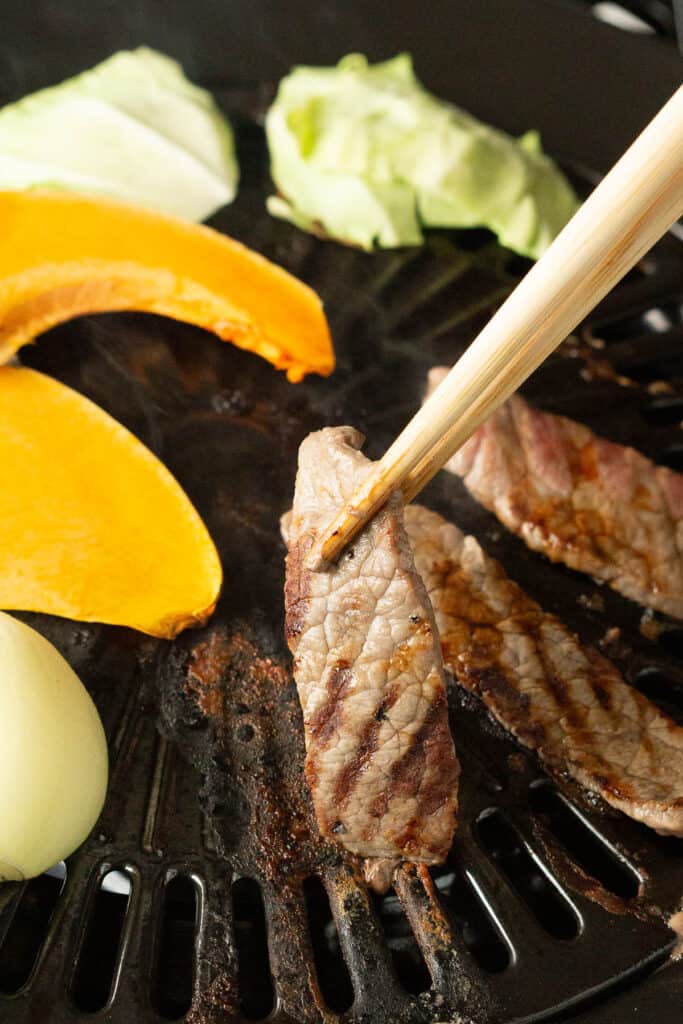
In This Post You’ll Learn
Why We Love This
There’s nothing better than having your closest friends or family over for a yakiniku. Everyone has fun cooking on the hibachi, and the food just tastes SO good!
Feel free to use this yakiniku recipe as is, or tweak it to make use of your favourite meats, seafoods, vegetables, mushrooms and marinades. Read on for more ideas!
Related: Shabu Shabu Hot Pot / Yakiniku Sauce
How to Pick the Best Meat for Your Next Yakiniku Night!
Just like hot pot, you want to ask your local butcher or scout out your supermarket for nice and thin slices of meat where possible. Here’s some of our top picks:
– Hot Pot Meat – Usually found in the freezer or fridge section of your local Asian supermarket, you’ll find a huge range of thinly sliced beef or pork that will cook nice and fast on the hibachi.
– Sandwich Steak, Sizzle Steak or Minute Steak – In Australia, this is one of our favourite options. It’s a little thicker than hot pot meat, but more widely available in most supermarkets. Simply slice up the steak into strips and you’re good to go! It’s usually available in both beef and pork options.
– Pork Rashers or Pork Belly Slices – These are the BBQ Ultimates (in our mind anyway!). As they’re high on the fat ratio, you’ll find it can really crisp up and soak up that charcoal flavour. They can be found in most supermarkets or Asian grocers.
– Stir Fry Meat – If you can’t find thinly sliced, then stir fry sliced meat is your second best bet. Whether it’s beef, pork or chicken, the small strips should still cook fairly quickly on your hibachi.
– Hambagu (Japanese Hamburger Steaks) – Make smaller style hamburger patties and throw them on the grill too.
– Tofu Steaks! – If you’re veggo or vegan, don’t miss out, and slice up a big slab of firm tofu into thin steaks. Marinate your tofu beforehand for an even more epic flavour combo.
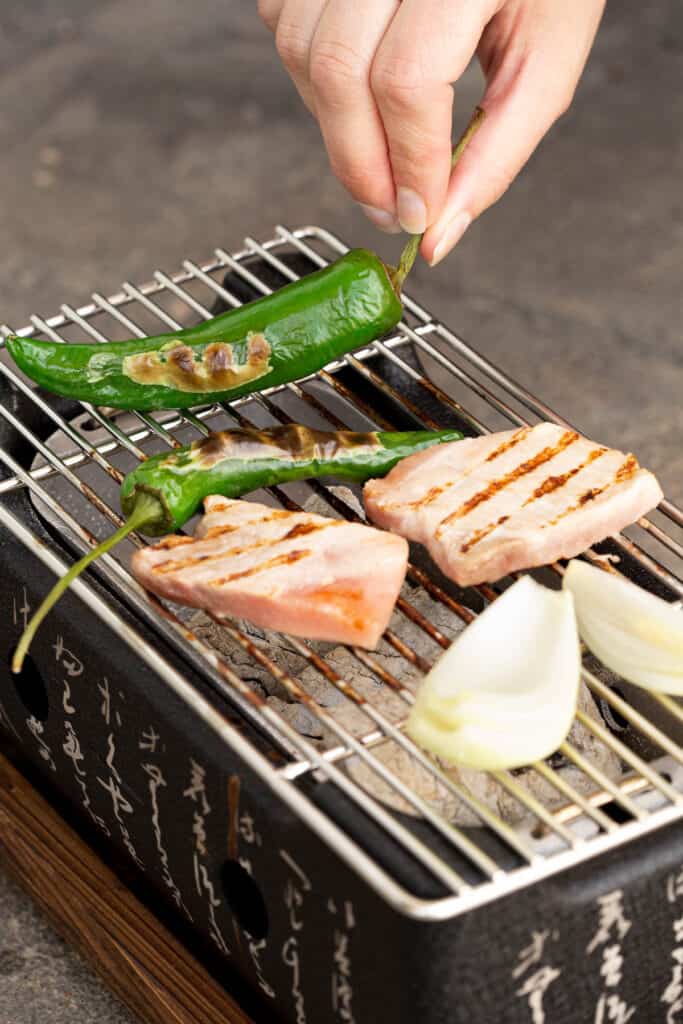
What is Yakiniku?
Yakiniku (焼肉 or やきにく) literally means grilled meat. While it can refer to any kind of meat or seafood, it’s often associated with thinly sliced pieces of beef or pork.
This dish is super popular in Japan, especially at yakiniku restaurants, where the ingredients are served raw and diners cook everything themselves on a grill embedded in the centre of the table.
Other times, the ingredients are traditionally cooked over a charcoal grill or Japanese hibachi. But when cooking at home, people will often use an electric yakiniku grill, flat teppan grill or a portable gas cooker with a circular grill plate.
Once cooked, the ingredients are then dipped in yakiniku dipping sauce (tare), which is not only tasty but also helps to cool each bite before you eat!
Yakiniku is a Japanese style of cooking inspired by Korean BBQ, and is often served with similar Korean-inspired side dishes such as kimchi, seasoned spinach and seasoned bean sprouts.
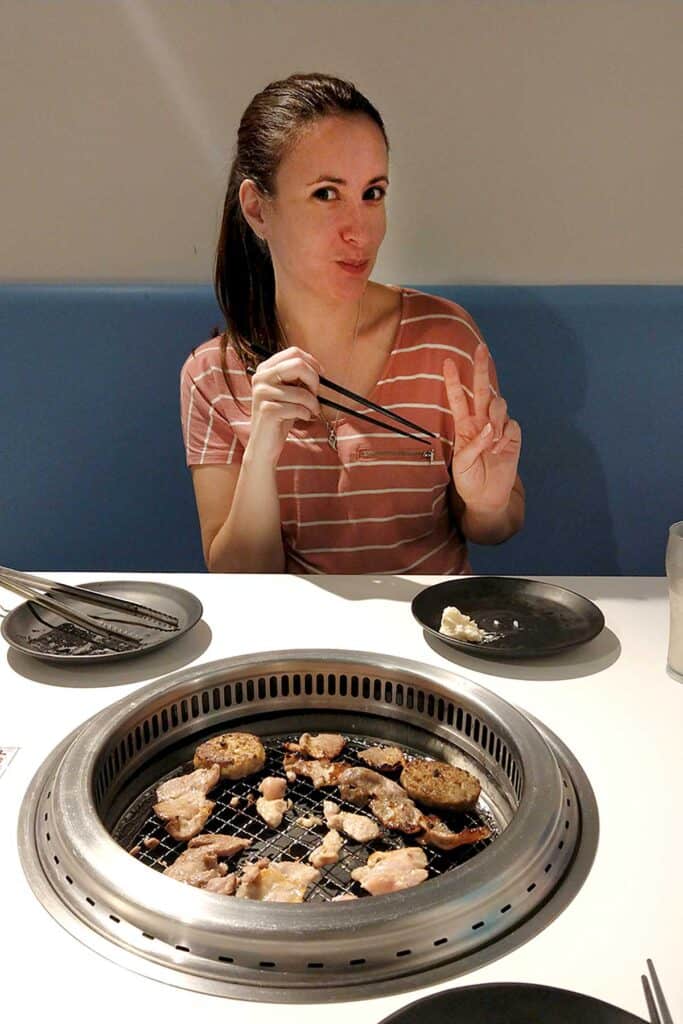
What You’ll Need
- Beef and/or Pork – Thin slices of well marbled beef are extra juicy and flavourful on the grill. You can also use short ribs (bone removed) or pork belly diced into small bite sized pieces.
- Vegetables – Today we’re using thin slices of Japanese pumpkin (also known as kabocha or kent pumpkin), chunky onion wedges, green peppers and green cabbage leaves diced into chunks. You can also add thin slices of oyster mushroom or small bunches of enoki or shimeji mushroom.
- Yakiniku Sauce – Find store bought yakiniku sauce from well stocked supermarkets or Asian grocers. It’s also super easy (and even tastier) to make homemade yakiniku sauce!
Other Ingredients and Marinade Ideas
- Beef Yakiniku – Plain or marinated in Korean bulgogi sauce or even the yakiniku sauce
- Chicken – Plain or marinated in teriyaki sauce
- Tsukune meatballs – Individually or on skewers
- Yakitori chicken – as pieces or on skewers
- Pork (or marinated with shogayaki ginger sauce
- Ribs – Usually served off the bone so it’s easier to cook and eat
- Seafood – Firm fish fillets (so they don’t fall apart), calamari or octopus
- Vegetables – Japanese pumpkin (also known as Kent), green cabbage, onion wedges
- Mushroom – Large oyster mushrooms sliced in half
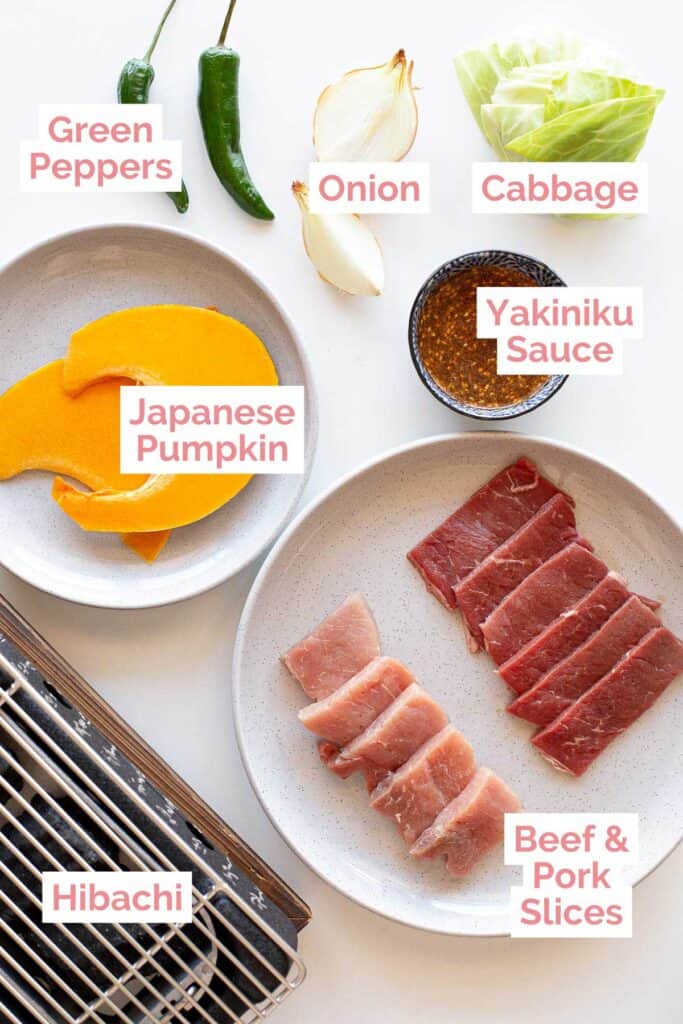
Hibachi Options for Yakiniku (BBQ Charcoal Grills)
Kinka Hibachi – Diatomaceous Earth
This was the top choice used by our friends in Hyuga, Japan. It’s a nice size to allow for a good amount of charcoal to get things HOT, while the diatomite walls help contain the heat and keep those outer walls cooler.
IronMaster Hibachi – Cast Iron
Honestly, this hibachi just looks cool. Aside from the aesthetics, it’s also made from robust cast iron, so you know it’s going to last. The only downside, is this one will be heavy if you’re going to be moving it around or travelling.
Being cast iron, it also means there’s no chemical coating on the grill.
Ippinka Hibachi – Metal
This lightweight hibachi is made from metal, but also comes with a wooden base.
The metal frame looks like it can hold a lot more charcoal than the diatomite or cast iron models, but being a thinner metal, you will get those sides heating up far more! On the upside, it would be better for camping and travelling due to the weight.
Happy Sales Tabletop Hibachi – Non-Stick Aluminium
For those that don’t like the clean up of a traditional hibachi grill or cast iron, you might be better off with a non-stick hibachi. This is much more similar to Korean BBQ, and you can easily wipe down the plates after cooking without the meat and sauces getting stuck and cooked on too bad.
This is another lightweight option too, which makes it a great choice for travelling.
Wandercook’s Tips
- Protect Your Cooking Area – Line your cooking area with newspaper to soak up any splashes and keep your surface clean.
- Take Your Time – Only cook a few pieces of meat or vegetables at a time. That way you have plenty of time to savour each piece and won’t risk burning anything if you can’t eat them quick enough. Allow plenty of space between each piece so they can cook evenly.
- Cooking Utensils – Mini tongs are great for cooking yakiniku, otherwise you can also use chopsticks (set aside a dedicated pair just for cooking – always use separate chopsticks for eating).
- Mini Alfoil Trays – You can fold aluminium foil into small trays to simmer extra fine ingredients in a liquid based sauce (like shredded onion, daikon, or garlic in sesame oil.)
- Assign a “Head Chef” – If there’s too many cooks in the kitchen, and it’s getting a bit messy, assign a “head chef” to cook everything for everyone, and have each person point to the pieces of meat or vegetable they’d like once it’s cooked to their preference.
FAQs
If you are cooking with a gas BBQ or traditional Japanese hibachi grill over charcoal, you should always cook outdoors.
Otherwise, if you plan to cook it on a tabletop electric grill, you can easily cook this dish inside. Just be aware that cooking meat this way will usually result in some yummy smells that may emanate through your dining room and possibly linger for a day or two.
You can easily cook the yakiniku meat and vegetables in a non-stick frying pan, skillet or wok and just stir fry the ingredients separately or together. Slice them into smaller bite size pieces if you do.
But did you know, you can also cook it in a cast iron takoyaki pan like this one over a gas stove. Oil the pan first and bring it up to temperature, then add the meat. Top with your choice of garlic, green onion, toasted sesame seeds etc.
Pour in a splash of yakiniku sauce or just drizzle with soy sauce and sesame oil. Stir to stop it sticking, and watch carefully so you don’t overcook.
You can serve it with traditional Japanese sides like miso soup, takuan pickles and rice, or add some Korean style banchan like kimchi, seasoned spinach, seasoned bean sprouts, pickled garlic or pickled onion.
Yakiniku meat is amazing on rice bowls such as Korean bibimbap or Japanese yakiniku don, with your choice of Japanese bbq sauce or bibimbap sauce!
Otherwise, try serving it in lettuce cups with gochujang sauce for extra spice, or add the cooked meat to salads to lighten it up.
If you plan to use a marinade, place your chosen marinade ingredients in a large bowl. Add the thinly sliced meat and stir gently to make sure each piece is well coated. If you have the time, allow it to marinate in the fridge for around 20-30 mins before cooking for the flavour to fully soak into the meat. It’s not essential, but it will taste extra amazing if you do!
– Yakiniku sauce
– Ponzu sauce
– Goma dare
– All Purpose Gochujang Sauce
– Tonkatsu Sauce
– Umami Sauce
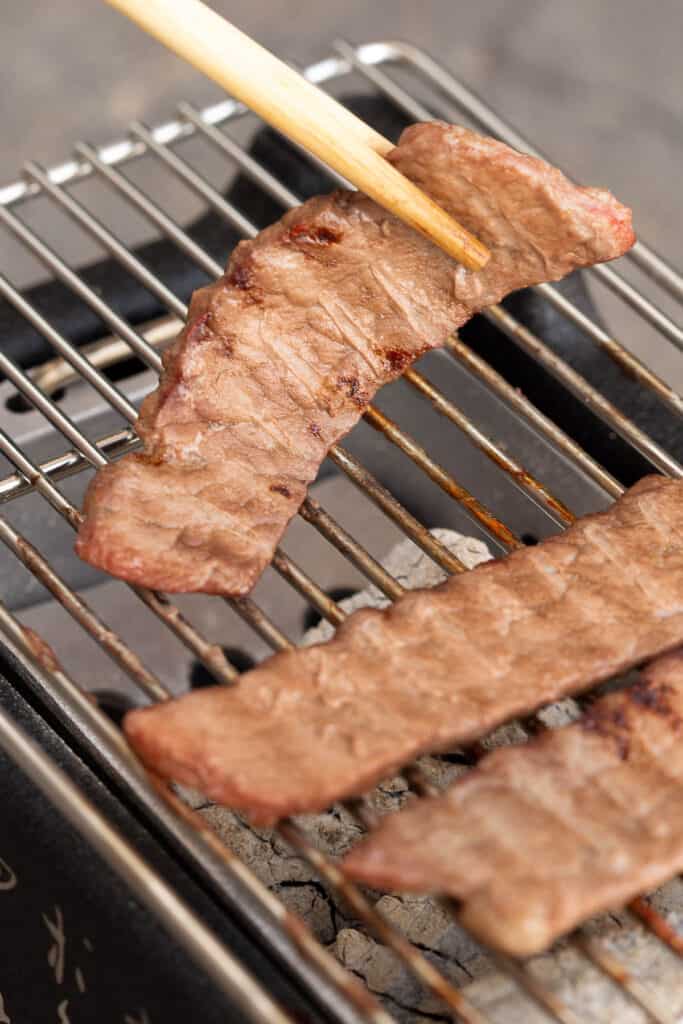
Try these amazing recipes next:
★ Did you make this recipe? Please leave a comment and a star rating below!
Ingredients
- 400 g beef steak 14.1 oz, thinly sliced
- 400 g pork 14.1 oz, thinly sliced
- 200 g pumpkin 7 oz, Japanese / Kent is best.
- 4 green peppers large, medium heat, sub capsicum for no heat
- 1 onion
- ¼ cabbage
- ¼ cup yakiniku sauce homemade or store bought
Instructions
- Prepare all the ingredients you’ll be cooking with such as beef, pork, pumpkin, green peppers and onion. Layer them out on plates, so it’s easy for everyone to pick up their own slices to cook.400 g beef steak, 400 g pork, 200 g pumpkin, 1 onion, ¼ cabbage, 4 green peppers
- Prepare your dipping sauces (such as yakiniku sauce) near your hibachi ready to dip after grilling.¼ cup yakiniku sauce
- Heat up your cooker – whether you’re using electric, gas or a traditional charcoal based yakiniku hibachi grill.
- You'll want a pair of eating chopsticks for everyone joining in the yakiniku party, then a pair of cooking chopsticks and / or skinny long tongs. Note: Never use the eating chopsticks to cook with, as this can damage them and it's not healthy or hygienic to touch raw meat then eat with the same utensil.
- Cooking times: Thinly sliced meat will usually take around 30 seconds per side, but it heavily depends on how thick the slices are. Once there's no more pink, you're good to go! Vegetables will vary in cooking time and personal preference. Some people like their veggies charred on the hibachi, while others like a light sear on both sides. It's up to you!
- Use the cooking chopsticks or tongs to place your selected meat or vegetables on your plate once you're ready to eat. You can then eat it plain, or dip it in your favourite sauce using your eating chopsticks.
Recipe Notes
- Protect Your Cooking Area – Line your cooking area with newspaper to soak up any splashes and keep your surface clean.
- Take Your Time – Only cook a few pieces of meat or vegetables at a time. That way you have plenty of time to savour each piece and won’t risk burning anything if you can’t eat them quick enough. Allow plenty of space between each piece so they can cook evenly.
- Cooking Utensils – Mini tongs are great for cooking yakiniku, otherwise you can also use chopsticks (set aside a dedicated pair just for cooking – always use separate chopsticks for eating).
- Mini Alfoil Trays – You can fold aluminium foil into small trays to simmer extra fine ingredients in a liquid based sauce (like shredded onion, daikon, or garlic in sesame oil.)
- Assign a “Head Chef” – If there’s too many cooks in the kitchen, and it’s getting a bit messy, assign a “head chef” to cook everything for everyone, and have each person point to the pieces of meat or vegetable they’d like once it’s cooked to their preference.
Nutrition
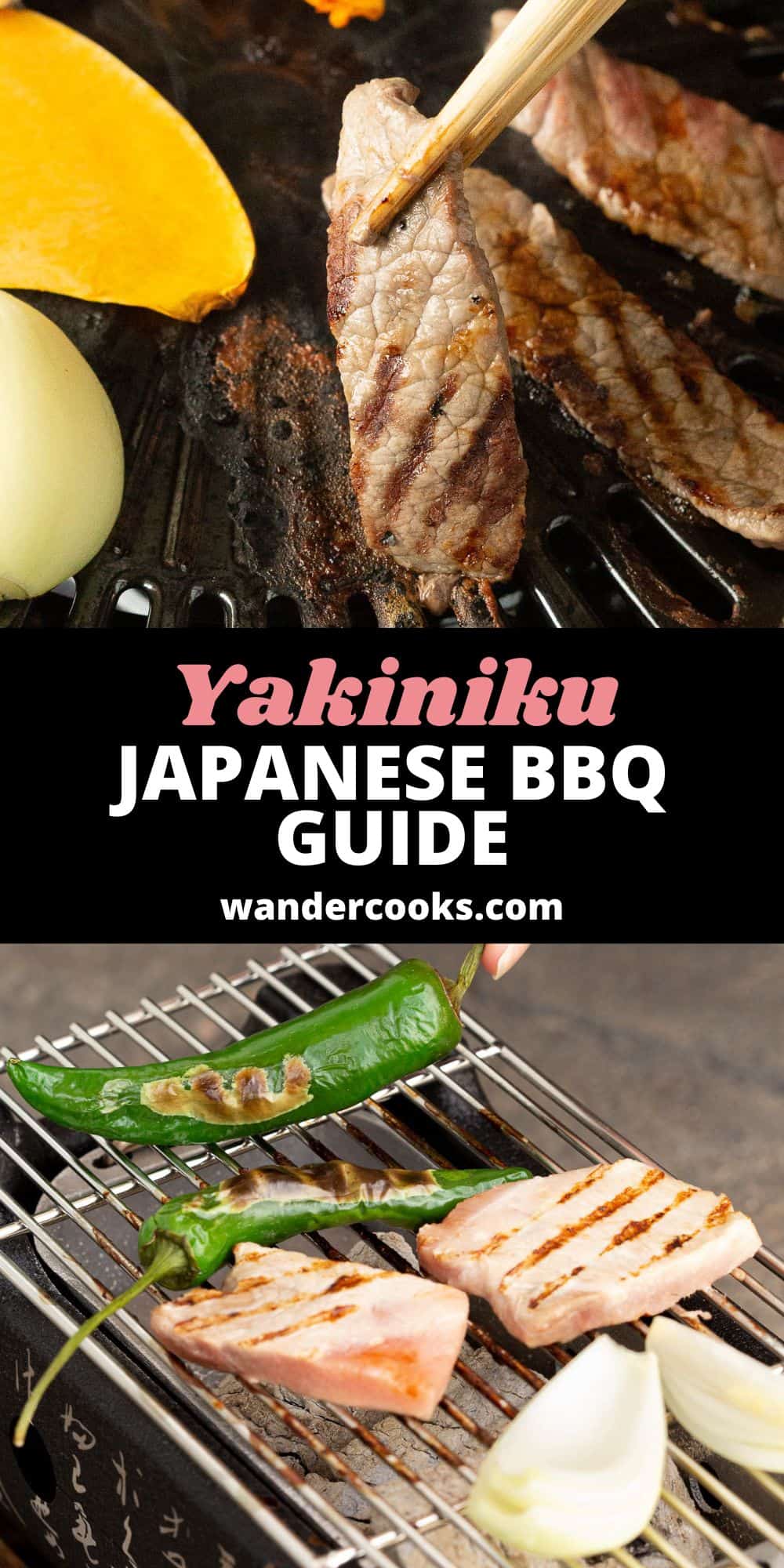

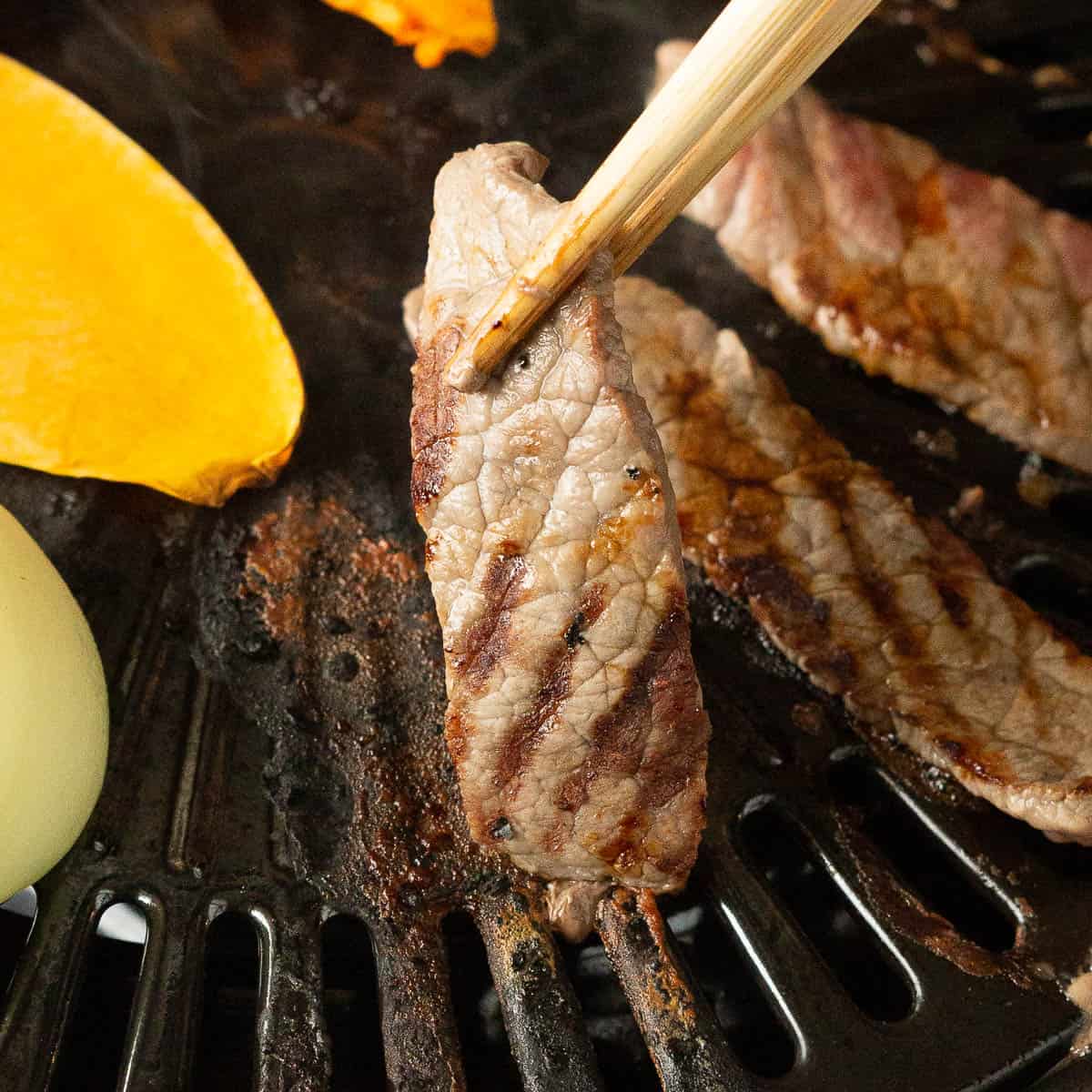


No Comments